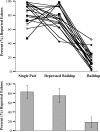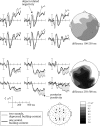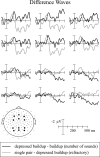Manipulations of listeners' echo perception are reflected in event-related potentials
- PMID: 21303011
- PMCID: PMC3055288
- DOI: 10.1121/1.3514518
Manipulations of listeners' echo perception are reflected in event-related potentials
Abstract
To gain information from complex auditory scenes, it is necessary to determine which of the many loudness, pitch, and timbre changes originate from a single source. Grouping sound into sources based on spatial information is complicated by reverberant energy bouncing off multiple surfaces and reaching the ears from directions other than the source's location. The ability to localize sounds despite these echoes has been explored with the precedence effect: Identical sounds presented from two locations with a short stimulus onset asynchrony (e.g., 1-5 ms) are perceived as a single source with a location dominated by the lead sound. Importantly, echo thresholds, the shortest onset asynchrony at which a listener reports hearing the lag sound as a separate source about half of the time, can be manipulated by presenting sound pairs in contexts. Event-related brain potentials elicited by physically identical sounds in contexts that resulted in listeners reporting either one or two sources were compared. Sound pairs perceived as two sources elicited a larger anterior negativity 100-250 ms after onset, previously termed the object-related negativity, and a larger posterior positivity 250-500 ms. These results indicate that the models of room acoustics listeners form based on recent experience with the spatiotemporal properties of sound modulate perceptual as well as later higher-level processing.
Figures




Similar articles
-
Difference in precedence effect between children and adults signifies development of sound localization abilities in complex listening tasks.J Acoust Soc Am. 2010 Oct;128(4):1979-91. doi: 10.1121/1.3478849. J Acoust Soc Am. 2010. PMID: 20968369 Free PMC article.
-
One sound or two? Object-related negativity indexes echo perception.Percept Psychophys. 2008 Nov;70(8):1558-70. doi: 10.3758/PP.70.8.1558. Percept Psychophys. 2008. PMID: 19064498 Free PMC article.
-
Attention is critical for spatial auditory object formation.Atten Percept Psychophys. 2015 Aug;77(6):1998-2010. doi: 10.3758/s13414-015-0907-4. Atten Percept Psychophys. 2015. PMID: 25939699 Free PMC article.
-
Pitch, harmonicity and concurrent sound segregation: psychoacoustical and neurophysiological findings.Hear Res. 2010 Jul;266(1-2):36-51. doi: 10.1016/j.heares.2009.09.012. Epub 2009 Sep 27. Hear Res. 2010. PMID: 19788920 Free PMC article. Review.
-
Sensitivity and selectivity of neurons in auditory cortex to the pitch, timbre, and location of sounds.Neuroscientist. 2010 Aug;16(4):453-69. doi: 10.1177/1073858410371009. Epub 2010 Jun 7. Neuroscientist. 2010. PMID: 20530254 Review.
Cited by
-
The precedence effect: fusion and lateralization measures for headphone stimuli lateralized by interaural time and level differences.J Acoust Soc Am. 2013 May;133(5):2883-98. doi: 10.1121/1.4796113. J Acoust Soc Am. 2013. PMID: 23654394 Free PMC article.
-
Neural time course of visually enhanced echo suppression.J Neurophysiol. 2012 Oct;108(7):1869-83. doi: 10.1152/jn.00175.2012. Epub 2012 Jul 11. J Neurophysiol. 2012. PMID: 22786953 Free PMC article.
-
Original speech and its echo are segregated and separately processed in the human brain.PLoS Biol. 2024 Feb 15;22(2):e3002498. doi: 10.1371/journal.pbio.3002498. eCollection 2024 Feb. PLoS Biol. 2024. PMID: 38358954 Free PMC article.
-
The precedence effect in sound localization.J Assoc Res Otolaryngol. 2015 Feb;16(1):1-28. doi: 10.1007/s10162-014-0496-2. Epub 2014 Dec 6. J Assoc Res Otolaryngol. 2015. PMID: 25479823 Free PMC article. Review.
-
Local inhibition of GABA affects precedence effect in the inferior colliculus.Neural Regen Res. 2014 Feb 15;9(4):420-9. doi: 10.4103/1673-5374.128250. Neural Regen Res. 2014. PMID: 25206830 Free PMC article.
References
-
- Bess, J., and Ruhm, H. (1972). “Recovery cycle of the acoustically evoked potential,” J. Speech Hear. Res. 15, 507–517. - PubMed
-
- Blauert, J. (1997). Spatial Hearing: The Psychophysics of Human Sound Localization (MIT Press, Cambridge, MA: ), pp. 1–480.
Publication types
MeSH terms
Grants and funding
LinkOut - more resources
Full Text Sources

